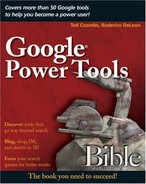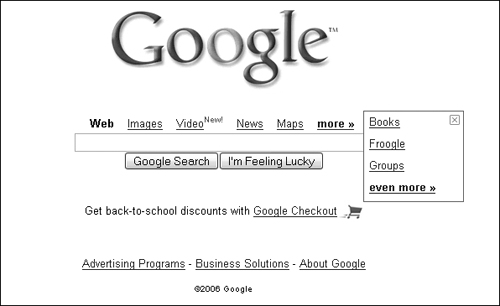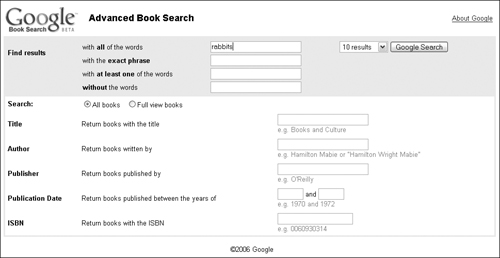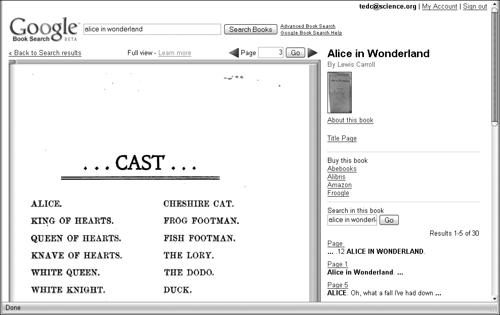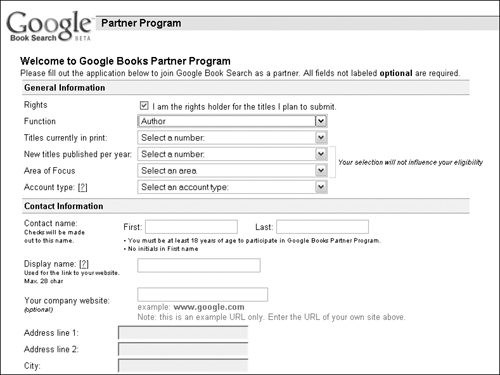Find books using Google Book Search
Use the Advanced Search features to focus your book search
Discover detailed information about books that interest you
Read entire books in the public domain
Librarians learn to use Google Book Search in your library
Learn about the Google Books Partner Program
It may seem unusual that one of Google’s key search areas is for books, one of its few non-digital-oriented search technologies. It’s going to be a very long time before we see the end of paper books. Google’s Book search allows you to discover books that you’d like to purchase or obtain. Once you “discover” a book you can buy it online, or use Google’s library catalog system discussed later in this chapter.
It was actually the Google Book project that formed the foundation of Google in the very beginning. While creating software to help index digitized books while working as researchers on the Stanford Digital Library Technologies Project Google founders, Larry Page and Sergey Brin, created a crawler named BackRub. It was the work they did on BackRub that formed the foundation of Google’s PageRank system, the core of the Google search technology.
Google Book Search is NOT a bookstore, and Google does not make money if you purchase books through its search pages. This is important to know so that you can be assured that the search results you view are not biased to allow for greater book sales. You may find contextual ads placed on some of the book pages by permission of the publisher. Clicking on these ads is how Google pays its employees.
Google obtains books from authors and publishers in order to scan them and make portions of the books available online, and allow for searches through the text. Google also maintains partnerships with libraries. Some of the book types scanned by Google include
Fiction
Non-fiction
Reference
Textbooks
Children’s books
Scientific
Medical and Legal
To access Google Book Search, navigate to books.google.com or from the main Google page click the more>> link. Click Books in the pop-up menu that appears, as shown in Figure 6.1.
Begin your search by typing search terms into the Google Book Search search box. Your search terms can include the author’s name, part of the author’s name, all or part of the book title, or text that might be found in the book. Press Enter or click Search Books after typing your search terms.
A list of books appears. A small thumbnail image of the book cover may appear next to the snippet of information about each book. The book information contains the following:
The book title as a clickable link
The author’s name
Subject category
Publication year
A small bit of the text
Any of these optional features—Table of Contents, Index, and About this book
Google Book Search allows you to search for books based on whether the book is fully available through Google. The search choices are All books and Full view books. Books that are fully viewable are in the public domain, the copyright has expired, or the publisher has asked Google to make the entire book available through Google.
Select your view by selecting the radio button beneath the Google Book Search box. Selecting All books enables you to see what type of view is available for that book. The view choices are:
Snippet View: Extremely brief cutaway view of the book.
Limited Preview: Normally contains the Table of Contents or the Index, or About the book, or some combination of these.
No preview available: You are not able to preview any portion of the book.
Full view: Entire book is available for viewing.
When you select Full view, only books with their entire contents available for viewing appear in your results.
When you need extra assistance in finding a book, you can choose to use the Google Advanced Book Search page. Click the Advanced Book Search link next to the search box on the Google Book Search main page. This launches the Advanced Book Search page, as shown in Figure 6.2.
The first portion of the Advanced Search Page helps you narrow your search with keywords and phrases. The Find results section allows you to do the following:
Find results with all the words: All keywords typed must be in the result.
Find results with the exact phrase: The keywords you type are treated as a phrase.
Find results with at least one of the words: Each keyword is treated separately, and the result need only contain one of the keywords if you type more than one in this field.
Find results without the words: Limits the search by making certain that your results do not contain the word or words typed in this field.
The same view selection that is available from the main Google Book Search box is also available in the Advanced Book Search page. Choose between All books and Full view books by selecting the appropriate radio button.
The next five advanced search fields deal with book information such as title and International Standard Book Number (ISBN) rather than the text of the book. This is a simple way to limit your book search when you know the author, the title of the book, the publisher, the range of years in which the book was published, or the ISBN of the book. Type the requested information in the following fields to further limit your search:
Return books with the title: Type all or part of the book title.
Return books written by: Type all or part of the author’s name.
Return books published by: Type the name of the publisher. Depending on the publisher this can return a large number of results without adding further search criteria.
Return books published between the years of: Provide a range of dates in which the book was published.
Return books with the ISBN: If you type the exact ISBN, a single book result should appear.
You can optionally choose how many results you want to appear on each page by selecting from the drop-down list in the top right of the page next to the Google Search button. The default is 10 results per page, but you can select 10, 20, 30, 50, or 100 results per page.
To begin your search, click Google Search.
Your search results, provided that they find books with your search criteria, appear as a list of books. To view the book detail, click the title of the book, which appears as a clickable link. The book’s detailed information appears as shown in Figure 6.3. In this example, Alice in Wonderland by Lewis Carroll is selected.
Essential information, such as the book’s title, author, and when available, a scan of the cover, is displayed. The book cover and title pages normally appear as clickable thumbnails. Clicking the thumbnail displays a much larger view of either the cover or title page. The book detail in Figure 6.3 displays only the title page of this 1897 work.
In addition to the About this book link shown in Figure 6.3, some books have a More about this book link displayed in the column on the right. Clicking this link displays a synopsis of the book, a link to a Web search for reviews on the book, a link to other Web pages related to the title, and detailed bibliographic information. This information contains details not shown normally in the detail page. These are details such as whether the book is paperback or hardcover, the dimensions, and the total number of pages.
The next section of the detail page provides a list of places you can buy the book online. To purchase the physical book, click one of the links in this section. Clicking the Froogle link displays a list of vendors with comparative pricing. Remember, Google Book Search is not a bookstore and makes no money when you purchase the book.
Google maintains the entire text of the book in its archive. Even when the entire book is not available for viewing, you can still search through the book for keywords. Type a keyword or phrase in the Search in this book search box and click the Go button.
The results of your search within the book are displayed for you in the column below the search box. Each result displays the line of text containing your keyword or phrase and the page number is listed above as a clickable link. When copyright restrictions apply you will be limited to the number of pages of the book you are able to view. Therefore, select the page for viewing carefully. Google keeps track!
There are two primary ways to preview the book. One is to view the pages that Google selects for you to preview, and the second is to perform a keyword search through the text and view specific pages of interest to you.
The scanned text of the book appears in the viewer on the left side of the book’s detail page. You may need to use the scroll bar in your Web browser to view the entire page. You can then “turn the page” by clicking the left and right blue arrow keys above and below the right corners of the page (refer back to Figure 6.3). The current page number is displayed between the arrows. Viewing the next page increments the counter of total number of viewable pages when copyright restrictions are in place.
In some cases, certain pages are restricted by the publisher and cannot be viewed as part of the preview. Additionally, certain images are restricted through copyright and the publisher may not have the right to display the image within Google Book Search. In this event, the image is replaced with the note Copyrighted Image.
In much the same way as you watch videos, which is described in Chapter 5, once you find a book and read through the preview, some publishers allow you to purchase access to the full content of the book online. Similar to how Google does not allow you to copy an entire video, the contents of the books remain on the Google site. This means that in order to read the book you must have Internet access. This copy protection mechanism allows you to read the book whenever you want. Just log in to your Google account and begin reading. The interface is easy to use, as shown previously in Figure 6.3.
Note
As of the publishing date of this book, the online reading of purchased books was not available.
Some books are available to be read in their entirety when either the copyright has expired or when the book is in the public domain (see the next section). To read the entire book, use the blue page number arrows above and below the book pages as you would when previewing a limited sampling of a book. You may also type a specific page number and click Go. This page number feature does not appear in works with limited previews.
Some books are written for the common good of the people and are never copyrighted. Additionally, copyrights eventually expire. These works, along with books written for the common good, are considered in the public domain. For example, this chapter uses Alice in Wonderland, which was written by Lewis Carroll in 1897. The copyright on this work expired long ago and the book is now considered to be in the public domain. By the way, if you’ve seen the movie, try reading the book. It’s fun.
Google researchers have been working for years with organizations and libraries around the world to speed up the scanning of public domain books to make them available in digital format. The goal is not to replace printed books but to form a foundation of information that inspires new books, protecting the copyright of authors. When a copyright expires (current law says that happens with books 70 years after the death of the author), the books enter the public domain. Some of the organizations working to digitize the world’s public domain written word are:
The Gutenberg Project (www.gutenberg.com)
Universal Library (www.ul.cs.cmu.edu/html)
Million Book Project (www.archive.org/details/millionbooks)
American Memory (http://memory.loc.gov/ammem/index.html)
If you know of a public domain work not included in the Google Book search you should let Google know. Also, if you see a book in the Google Book search that is incorrectly labeled as public domain or not in the public domain, let Google know by sending e-mail to: [email protected].
When the Find this book in a library link appears in the book detail you can click it and Google takes you to the OCLC Worldcat (world catalog). Type your ZIP code in the OCLC catalog to find the book in a library near your home or office.
When you have the Google Toolbar installed and you visit a Web page that contains an ISBN (this could be any Web page), the AutoLink button changes to Show Book Info. Clicking Show Book Info on the toolbar changes all the ISBNs to links. Google determines where that link sends the user when clicked. It may be to the OCLC system or it may be to an online bookstore.
To better support the efforts of librarians, Google has created the Google Librarian Center found at www.google.com/librariancenter. Google feels that its mission is one similar to that of a librarian and wants to partner with librarians in attaining the common goal of access to the information stored in the world’s written word.
The Google Librarian Center allows librarians to join an e-mail list to enable them to keep up to date with the latest news and features offered by Google. You can also read an archive of the Google Librarian Newsletter by clicking the Newsletter Archive link on the left side of the page.
To help library patrons use Google more effectively, Google has made downloadable teaching tools for librarians. Click the Tools link on the left side of the Librarian Center Web page and download the teaching tools for use within your library.
Read the Tips of the Trade page to learn innovative and effective uses of Google from librarians around the world who are participating in the Google Tips of the Trade campaign. Click the Tips of the Trade link to navigate to this page. If you are a librarian, you may want to participate by sharing your own stories or ideas.
Google is partnering with authors and publishers to build its content for Google Book Search. Google is primarily looking for publishers who have books it wants to appear in the Google Book Search. Google also wants to partner with people who have self-published their books and with authors who currently own the copyright to their books.
Publishers have incentive to join the Google Partner Program. It’s a free way to promote book sales. People who do searches will find books, read the preview, and hopefully click a link to one of the online bookstores and immediately buy the book.
This is a great way for people find books in which they have an interest. More and more online bookstores allow readers to browse a few pages of the books, see the table of contents, and in some cases view the index of the book just as they do when browsing for books in a physical bookstore. Even though Google is not a bookstore, Google Book Search offers the same features and drives book sales.
Authors are not left out of the partner program. Google is looking for authors who have self-published their books. Additionally, when books go out of print, the copyright, once held by the publisher, normally returns to the author. At this time, the author may choose to work with Google by submitting the book. It might also be a great time to write a second edition of the book and self-publish it using Google to help market the book.
Another thing authors can do is to contact their publishers and convince them to send their books to Google for scanning. It’s important that authors take an active part in the marketing process.
Becoming a part of the Partner Program is simple. Just follow these steps:
Click the Join Now link on the left side of many of the Google Book Search Help pages. Google collects some basic information from you. It first needs to know if you are the person who owns the rights to the books.
Click the Function drop-down list to tell Google if you are an author, a publisher, a book distributor, publishing service, or other (see Figure 6.4).
Respond to the remaining General Information fields as in step 2.
Type your full name, mailing address, e-mail address, and telephone number in the field under “Contact Information.” When you complete the form, Google sends you an e-mail message.
Check your e-mail inbox and respond to the Google message by clicking the link in the e-mail message. You are not automatically enrolled in the program. Your application is reviewed by the Google Books staff, and you are notified of the decision.
Authors who are allowed to participate as partners because they have self-published or own the copyright to their books may open a Google Books account. In this way, they can manage book sales by reading detailed reports of things like:
Page views: How many people visited the Google Books Search Web page that features your book.
Ad clicks: How many people clicked on an ad placed within the book.
Buy this Book clicks: How many people chose to click on the Buy this Book link to purchase the book. This does not indicate they completed the purchase, only that they clicked the link.
Google essentially has three ways of obtaining books to be scanned: when publishers send books, when authors send books, and the Google Library Project, where books in libraries are being scanned and presented only with limited bibliographic information so the copyright is not violated. If you are an author with a Google Books account and you find that one of your books has been scanned as part of the Library Project, you can have it included in your Google Books account.
Authors participating in the Partner Program can send a list of books they do not want scanned as part of the Library Program. Authors who are not part of the program can still submit a list of books they want avoided by the Library Program. They simply need to submit additional information about themselves.
If you know of a library with a special collection that is currently not part of the Google search, ask your librarian to send an e-mail to: [email protected]. If you are the person in charge of a library collection, send Google the following information:
The name or title of the collection
The size of the collection in number of works or archived items
Description of the unique or specialized content
How much of the collection is already digitized
Languages used within the collection
For additional information about this process and what libraries are currently involved, visit: http://books.google.com/googlebooks/library.html.
Book searching is at the very heart of what formed Google in the first place. Google has worked with many of the book-digitizing projects to create an amazing online digital book resource. You can participate and use these resources simply as a person interested in finding a book or possibly buying a book, or as a publisher, author, or librarian. The search features for finding books are powerful. You may even find the answer you are looking for simply by doing keyword searches through the book itself.
Publishers and authors can promote their books by participating in the Google Books Partner Program. Google can scan your books and make them available for preview or purchase through several online bookstores. Although Google is not a bookstore, it makes shopping for books simple and powerful, very similar to the Google Catalog discussed in the next chapter.
